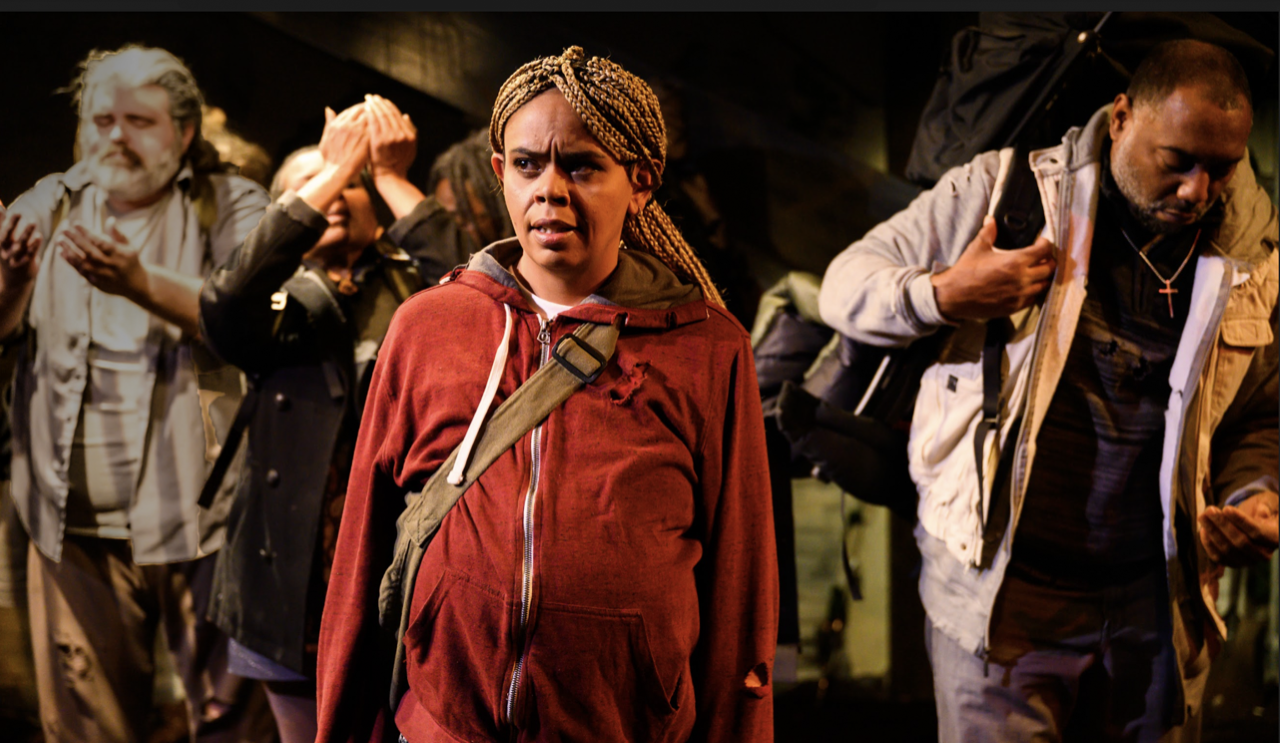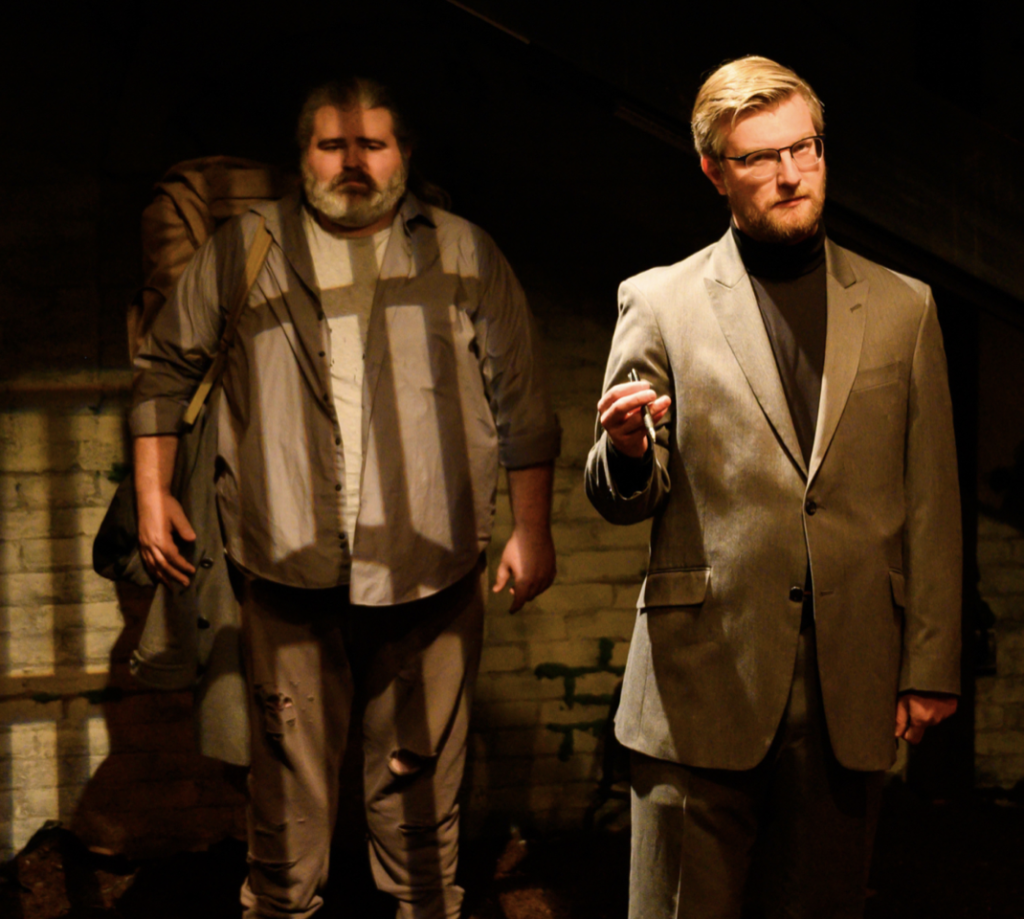By Susan Dunn
Heading to a show titled Cost of Living, I anticipated an evening of economists discussing the GNP. Given our current rampant politics, that would have seemed a fit.
Mercifully, Martyna Majok’s play is a more personal view of costs—economic, physical, and emotional. Four characters—two disabled and two caregivers—play out the feelings and the passions of their respective situations, juxtaposed against their class and educational backgrounds.
… Cost of Living is a “must see”…
In the opening scene, a feisty, loquacious Eddie (masterfully played all over the stage by high-energy Daniel Duque-Estrada), regales us from his bar stool about how the “shit in life is not to be understood.” We learn he’s lost his truck-driver’s license due to a DUI. Moreover, his estranged wife and texting mate has died, and in his loneliness and desperation, he continues to send text messages to her cell phone to comfort himself. When he gets text replies, he is confounded but also mysteriously buoyed.
The play is framed by two capable and well-cast disabled actors: Matty Placencia, who has met the emotional and physical challenges of cerebral palsy all his life, and Christine Bruno, whose accomplished acting resume has focused on a range of acting roles and disability-inclusion consulting.
In Majok’s play, Placencia embodies John, a young upper-class professor at Princeton, who partially manages with one functioning hand, a wheelchair, and a wealthy family, but requires a part-time caregiver for his daily personal hygiene. He is supercilious, defensive, and insensitive to needs other than his own. Christine Bruno plays Eddie’s paraplegic wife Ani, crippled by a traffic accident following her estrangement. Eddie has come back to care for her, hoping to share in her insurance proceeds. Bruno’s wide range of facial expressions and sharp and ironic tongue reveal her frustrations with her ex-husband. But she warms up to Eddie as her caregiver over time.
Finally, there is Carla Gallardo’s Jess, a 20-year-old Latina struggling to sustain herself with bar jobs and living in her car. In desperation she applies to be John’s caregiver, attracted by his higher-class aura and his financial means. Gallardo gains our sympathy through her wide range of expressivity while meeting the physical challenge of showering, shaving, and dressing John on stage before us. Prompted by John, her own challenged history ekes out as they get used to his routine.

Cost of Living is two plays with one set representing two apartments that occupy their own respective mini-set areas and finally merge together in the final scene. The mini-sets create difficulty for the arena staging, but are mostly well-handled by set designer Emilie Whelan. Blocking for disabled actors is also tricky, but necessary to play well to the three audience sections. Some scenes were partly obstructed by the five or more floating mini-sets.
For this reviewer, occasionally, actors’ words were lost when delivering lines away from parts of the audience, but in general the utilization of space clarifies the action and imaginatively creates an atmosphere with a single rear window. Projections keep us emotionally in the right plane with grey weather, rain or pelting snow.
With a complex story and characters that ring true as individuals in straits that could be our fate as well if we were not so fortunate, Cost of Living is a “must see.” The authenticity of the actors in this play demands kudos to the production.
-30-
 Since arriving in California from New York in 1991, Susan Dunn has been on the executive boards of Hillbarn Theatre, Altarena Playhouse, Berkeley Playhouse, Virago Theatre and Island City Opera, where she is a development director and stage manager. An enthusiastic advocate for new productions and local playwrights, she is a voting member of the SF Bay Area Theatre Critics Circle, and a recipient of a 2015 Alameda County Arts Leadership Award. Contact: [email protected]
Since arriving in California from New York in 1991, Susan Dunn has been on the executive boards of Hillbarn Theatre, Altarena Playhouse, Berkeley Playhouse, Virago Theatre and Island City Opera, where she is a development director and stage manager. An enthusiastic advocate for new productions and local playwrights, she is a voting member of the SF Bay Area Theatre Critics Circle, and a recipient of a 2015 Alameda County Arts Leadership Award. Contact: [email protected]
| Production | Cost of Living |
|---|---|
| Written by | Martyna Majok |
| Directed by | Emilie Whelan |
| Producing Company | Oakland Theater Project |
| Production Dates | Thru Mar 24th, 2024 |
| Production Address | Flax Art and Design, 1501 Martin Luther King Jr. Way, Oakland, CA 94612 |
| Website | www.oaklandtheaterproject.or |
| Telephone | (510) 646-112 |
| Tickets | $35-$60 |
| Reviewer Score | Max in each category is 5/5 |
| Overall | 4/5 |
| Performance | 4/5 |
| Script | 4/5 |
| Stagecraft | 4/5 |
| Aisle Seat Review PICK! | YES! |





